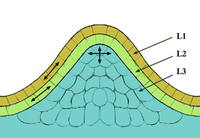
Photo from wikipedia
Vascular cambium, a lateral plant meristem, is a central producer of woody biomass. Although a few transcription factors have been shown to regulate cambial activity1, the phenotypes of the corresponding… Click to show full abstract
Vascular cambium, a lateral plant meristem, is a central producer of woody biomass. Although a few transcription factors have been shown to regulate cambial activity1, the phenotypes of the corresponding loss-of-function mutants are relatively modest, highlighting our limited understanding of the underlying transcriptional regulation. Here, we use cambium cell-specific transcript profiling followed by a combination of transcription factor network and genetic analyses to identify 62 new transcription factor genotypes displaying an array of cambial phenotypes. This approach culminated in virtual loss of cambial activity when both WUSCHEL-RELATED HOMEOBOX 4 (WOX4) and KNOTTED-like from Arabidopsis thaliana 1 (KNAT1; also known as BREVIPEDICELLUS) were mutated, thereby unlocking the genetic redundancy in the regulation of cambium development. We also identified transcription factors with dual functions in cambial cell proliferation and xylem differentiation, including WOX4, SHORT VEGETATIVE PHASE (SVP) and PETAL LOSS (PTL). Using the transcription factor network information, we combined overexpression of the cambial activator WOX4 and removal of the putative inhibitor PTL to engineer Arabidopsis for enhanced radial growth. This line also showed ectopic cambial activity, thus further highlighting the central roles of WOX4 and PTL in cambium development. The vascular cambium contains meristem cells that produce secondary xylem and phloem in the stems and roots of many plants. Its activity largely determines wood formation. Now, a genome-wide transcript profiling of Arabidopsis thaliana root cambium is presented to unlock the complex network that regulates cambium development and activity.
Journal Title: Nature plants
Year Published: 2019
Link to full text (if available)
Share on Social Media: Sign Up to like & get
recommendations!